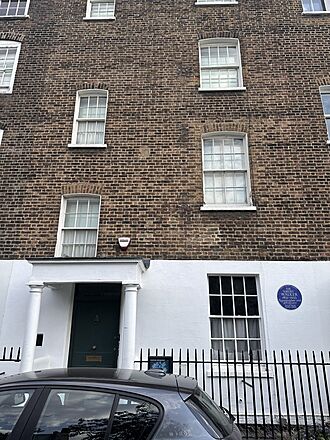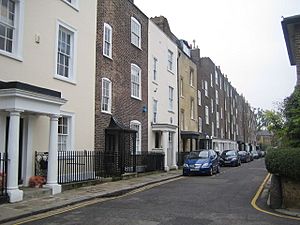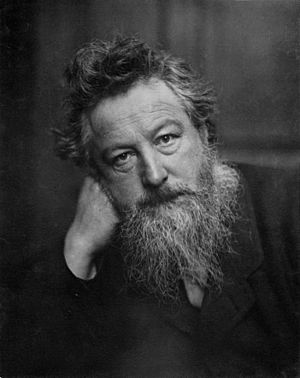7 Hammersmith Terrace facts for kids
Quick facts for kids 7 Hammersmith Terrace |
|
|---|---|
| General information | |
| Town or city | Hammersmith and Fulham, London |
| Country | England |
| Estimated completion | 1755 |
7 Hammersmith Terrace is a special historic house in London, England. It was once the home of Emery Walker, a famous English engraver and printer. Walker was a very important person in the Arts and Crafts movement, which was a style of art and design popular in the late 1800s and early 1900s.
Emery Walker was also a close friend of William Morris, a well-known textile designer who lived nearby. Walker decorated his home in the Arts and Crafts style, showing off his friendships and interests. The house is a "Grade II*" listed building, which means it's very important historically and architecturally.
After Walker passed away, his daughter Dorothy worked hard to keep the house and its contents just as they were. She even added more items from the Morris family. Because of this careful preservation, the house today is a unique example of an Arts and Crafts home, looking almost exactly as it did when Emery Walker lived there.
The Emery Walker Trust, a charity, now owns the house. They call it "the last authentic Arts and Crafts interior in Britain." You can visit the house by booking a guided tour. It's located in Hammersmith and Fulham, a part of London.
Contents
History of the House
The houses on Hammersmith Terrace, including number 7, were built around 1755. They offered a more affordable place to live compared to central London at the time. In the late 1800s and early 1900s, many artists and creative people lived on the Terrace. These included the actor F. G. Stephens and the calligrapher Edward Johnston.
Emery Walker moved into number 7 in 1903 with his family. Before that, he had lived at number 3 Hammersmith Terrace for 24 years.
How the House Was Preserved
When Emery Walker died in 1933, his daughter Dorothy took ownership of the house. She was determined to keep the house and everything inside it just as her father had left them. When Dorothy passed away in 1963, the house went to her nurse and companion, Elizabeth de Hass. Elizabeth continued Dorothy's efforts to preserve the house, so it remained almost unchanged.
Before Elizabeth de Hass died in 1999, she talked to experts about setting up a trust to look after the property. The Emery Walker Trust was created in February 1999. Money was raised by selling some of Walker's private print collection to help set up the Trust. The Trust then became the owner of the house.
Visiting Today
The Emery Walker Trust first opened the house to the public in April 2005. At first, there were worries that they might not be able to keep it open due to money issues. However, the house has offered pre-booked guided tours every summer since then.
A special blue plaque is on the house. These plaques are put on buildings in London to remember famous people who lived or worked there. This one honors Emery Walker.
Inside the House
The inside of 7 Hammersmith Terrace is a fantastic example of the Arts and Crafts movement style. It has changed very little since Emery Walker lived there, thanks to the careful work of his daughter and her nurse. The house and its contents clearly show Walker's close friendship with the textile designer William Morris.
Walker and Morris became friends after Walker moved to Hammersmith Terrace. Their families remained close even after Morris's death in 1896. Morris's daughter, May Morris, gave several items to the Walker household. Some were given to Emery himself, and others to Dorothy when she inherited the house.
Special Items and Designs
- The linoleum (a type of floor covering) in the entrance area was designed by William Morris. It's the only known Morris linoleum still in its original home setting.
- The house also has patterned wall-hangings and a blue rug from the Morris household. Dorothy bought the rug at a house sale in 1939.
- You can even find some personal items that belonged to William Morris, like his spectacles and a lock of his hair.
Other items in the house came from people connected to the Arts and Crafts movement:
- When the architect Philip Webb died, Walker inherited all of his belongings. Some of Webb's furniture is still in the house.
- The drawing room has a special desk called a secretaire designed by Ernest Barnsley.
- The house also holds important documents, such as an original proof of The Earthly Paradise by Morris. There are also letters from the famous writer Rudyard Kipling.
- A teapot that belonged to the artist Dante Gabriel Rossetti is also there.
You can also see many of Emery Walker's own personal items. These include souvenirs from his trips abroad and his 1933 National Trust membership card.
Artworks in the House
The house displays several artworks, including:
- Two oil paintings by Samuel Butler, who was better known as a novelist. These paintings show Soglio and Westminster School.
- An oil painting called Christmas Roses by Anna Hornby.
- An oil painting by Neville Bulwer-Lytton, 3rd Earl of Lytton of his daughter, Madeline.




